Clobazam Thame 10Mg/5Ml Oral Suspension

Thame Laboratories
Package Leaflet: Information for the user Clobazam Thame 5mg/5ml Oral Suspension Clobazam Thame 10mg/5ml Oral Suspension
(clobazam)

Thame Laboratories
►
►
►
►
Read all of this leaflet carefully before you start taking this medicine because it contains important information for you.
Keep this leaflet. You may need to read it again.
If you have any further questions, ask your doctor, or pharmacist.
This medicine has been prescribed for you only. Do not pass it on to others.
It may harm them, even if their signs of illness are the same as yours.
If you get any of the side effects, talk to your doctor or pharmacist. This includes any possible side effects not listed in this leaflet. See section 4.
The name of your medicine is Clobazam
Thame 5mg/5ml or 10mg/5ml Oral
Suspension but will be referred to as
Clobazam throughout this leaflet.
What is in this leaflet:
1. What Clobazam is and what it is used for
2. What you need to know before you take Clobazam
3. How to take Clobazam
4. Possible side effects
5. How to store Clobazam
6. Contents of the pack and other information
| |
1. What Clobazam is and what it is
used for
v_/
This medicine contains the active substance clobazam which belongs to a group of medicines called benzodiazepines.
It works by having a calming effect on the brain.
Clobazam can be used for:
► Severe anxiety over a short time.
► Epilepsy (fits) over a longer time.
► Mental illness such as schizophrenia
(in combination with other treatments).
| |
2. What you need to know before you
take Clobazam
V_/
E3 Do not take Clobazam if:
► You are allergic (hypersensitive) to clobazam, other benzodiazepine medicines or any of the other ingredients of Clobazam (see section 6). Signs of an allergic reaction include: a rash, swallowing or breathing problems, swelling of your lips, face, throat or tongue.
► You are in the first three months of pregnancy or think you might be pregnant (see below under 'Pregnancy and breast-feeding' for more information).
► You are breast-feeding.
► You have ever had problems with drugs or alcohol dependence in the past.
► You suffer from an illness that causes muscle weakness (called 'myasthenia gravis').
► You have liver problems.
► You have breathing problems.
► You stop breathing for short periods during sleep (called 'sleep apnoea syndrome').
► The patient is under 6 years old.
Do not take if any of the above apply to you. If you are not sure, talk to your doctor or pharmacist before taking Clobazam.
Warnings and Precautions
Talk to your doctor or pharmacist before taking your medicine if:
► You have problems with controlling your movements (called 'spinal or cerebellar ataxia').
► You have depression, irrational fears and obsessions.
► You have delusions (believing things which are not true) or hallucinations (sensing things which are not there)
► You have kidney problems.
► You have ever become dependent upon another drug or alcohol. Alcohol should not be taken during treatment with Clobazam as there is an increased risk of experiencing side effects.
► You are over 65. This is due to increased sensitivity to adverse reactions in the elderly such as drowsiness, dizziness and muscle weakness. There is also an increased risk of fall that may result in serious injury.
PIL/UK/MFG013/04-05/v2~|
► You have difficulty digesting medicines.
In some patients liver may not metabolise (break down) medicines adequately.
In these patients the medicine may remain in the body for a longer period of time. This may result in side effects. If you are known to poorly metabolise certain medicines please speak to your doctor.
If you are not sure if any of the above apply to you, talk to your doctor or pharmacist before taking Clobazam.
Children
► Not recommended for children under 6 years of age.
► Careful assessment of the use must be made before using benzodiazepines in children.
Other medicines and Clobazam Please tell your doctor or pharmacist if you are taking or have recently taken or might take any other medicines. This includes medicines you buy without a prescription, including herbal medicines. This is because Clobazam can affect the way some other medicines work. Also some medicines can affect the way Clobazam works.
In particular, tell your doctor if you are taking any of the following:
► Medicines for epilepsy (such as phenytoin, carbamazepine, stiripentol or valproic acid).
► Medicines for depression (Monoamine Oxidase Inhibitors (MAOIs) such as phenelzine and isocarboxazid or tricyclic anti-depressants - such as trazodone) or Selective Serotonin Re-uptake Inhibitors (SSRIs) such as fluvoxamine or paroxetine.
► Medicines for severe mental illness called 'antipsychotics' (such as chlorpromazine, haloperidol, clozapine and pimozide).
► Painkillers (such as medicines containing codeine, dihydrocodeine or morphine).
► Sleeping tablets (such as zolpidem). Tranquilisers (such as diazepam, temazepam or lorazepam).
► Muscle relaxants (such as baclofen). Antihistamines that make you sleepy (such as chlorphenamine, promethazine or diphenenhydramine).
► Lithium - used for a mental illness called 'manic-depressive illness' (mood changes between a state of high excitability or exaggerated emotions and depression).
► Cimetidine - used to treat ulcers and heartburn.
► Omeprazole - used to treat the symptoms of acid reflux such as heartburn or acid regurgitation.
► Ticlopidine - an antiplatelet medication used in patients with an increased risk of stroke.
► Fluconazole - used in the treatment of fungal conditions.
► Dextromethorphan - used to relieve dry, irritating coughs.
► Nebivolol - medicine used to treat high blood pressure.
If you are not sure if any of the above apply to you talk to your doctor or pharmacist. Anaesthetics
If you are going to have an anaesthetic, tell your doctor or anesthetist that you are taking Clobazam. This is because your doctor may need to change the amount of anaesthetic or muscle relaxants to give you.
o Driving and using machines
fl You may feel sleepy or have
concentration or memory problems after taking this medicine. You may also experience double vision or you may react more slowly to things. If this happens, do not drive or use any tools or machines.
The medicine can affect your ability to drive as it may make you sleepy or dizzy.
► Do not drive while taking this medicine until you know how it affects you.
► It is an offence to drive if this medicine affects your ability to drive.
► However, you would not be committing an offence if:
• The medicine has been prescribed to treat a medical or dental problem and
• You have taken it according to the instructions given by the prescriber or in the information provided with the medicine and
• It was not affecting your ability to drive safely.
Talk to your doctor or pharmacist if you are not sure whether it is safe for you to drive while taking this medicine.
Clobazam contains:
This medicine contains methyl parahydroxybenzoate (E218), which may cause allergic reactions (possibly delayed).
This medicine also contains sucralose (E955). If you have been told by your doctor that you have an intolerance to some sugars, contact your doctor before taking this medicinal product.
This medicinal product also contains 0.097mmol (2.24mg) of sodium per dose of clobazam (5ml). To be taken into consideration by patients on a controlled sodium diet.
3. How to take Clobazam
Always take this medicine exactly as your doctor has told you. You should check with your doctor or pharmacist if you are not sure.
Taking this medicine
► If you feel the effect of your medicine is too weak or too strong, do not change the dose yourself, but ask your doctor.
► Keep taking Clobazam until your doctor tells you to stop.
Clobazam is usually given for 2 to 4 weeks. After that, your doctor will decide whether you should keep taking this medicine.
Clobazam with food, drink and alcohol
Do not drink alcohol while taking Clobazam. This is because there is an increased risk of sleepiness and other side effects.

Pregnancy,breast-feeding and fertility
Do not take Clobazam if you are:
► In the first three months of pregnancy
► Breast-feeding. This is because it may pass into the mother's milk
Talk to your doctor before taking this medicine if you are pregnant, plan to get pregnant or think you may be pregnant.
This is because Clobazam is not recommended for use in pregnant women.
However, your doctor may give you this medicine during late pregnancy or during labour.
► If this happens, there is a risk of having a baby with a low body temperature, floppiness, breathing or feeding problems
► If this medicine is taken regularly in late pregnancy, your baby may get withdrawal symptoms. In this case the newborn should be closely monitored during the postnatal period.
The recommended doses are:
|
5mg/5ml |
10mg/5ml | |
|
Adults |
The usual |
The usual |
|
dose is 20- |
dose is | |
|
30ml (20- |
10ml-15ml | |
|
30mg) |
(20-30mg) | |
|
each day. |
each day. | |
|
This can |
This can | |
|
be taken |
be taken | |
|
as two |
as two | |
|
separate |
separate | |
|
doses or |
doses or | |
|
as a single |
as a single | |
|
dose at |
dose at | |
|
night. Your |
night. | |
|
doctor |
Your | |
|
may |
doctor | |
|
increase |
may | |
|
your dose |
increase | |
|
up to 60ml |
your dose | |
|
(60mg) |
up to 30ml | |
|
each day. |
(60mg) | |
|
Your |
each day. | |
|
doctor |
Your | |
|
may lower |
doctor | |
|
the dose |
may lower | |
|
to suit |
the dose | |
|
you. |
to suit you. | |
|
Children |
The usual |
The usual |
|
(over 6 |
starting |
starting |
|
years) |
dose is 5ml |
dose is |
|
(5mg) each |
2.5ml | |
|
day. |
(5mg) each day. | |
|
The usual |
The usual | |
|
Older |
dose for |
dose for |
|
people |
anxiety is |
anxiety is |
|
10ml -20ml |
5ml- 10ml | |
|
(10-20mg) |
(10-20mg) | |
|
each day. |
each day. |
TURN OVER
Method of administration
This product may settle during storage. Shake the bottle well before use.
Use the measuring syringe provided in the pack to deliver the required dose.
When you are taking medicines like Clobazam you should not use a different clobazam containing medicine except under your doctor's supervision.
Instructions for the use of syringe:
1. Open the bottle: press the cap down and turn it anticlockwise (Figure 1).
2. Seperate the adaptor from the syringe (figure 2). Insert the adaptor into the bottle neck (figure 3). Ensure it is fixed well.
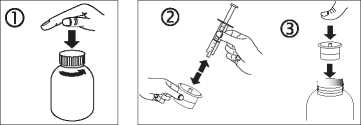
Take the syringe and put it in the adaptor opening (figure 4). Turn the bottle upside down (figure 5).
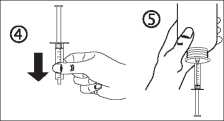
3. Fill the syringe with a small amount of solution by pulling the piston down (figure 5A), then push the piston up in order to remove any possible air bubbles (figure 5B). Pull the piston down to the graduation mark corresponding to the quantity in millilitres (ml) prescribed by your doctor (figure 5C).
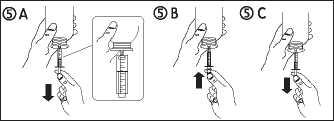
4. Turn the bottle the right way up
(figure 6A). Remove the syringe from the adaptor (figure 6B). Empty the contents of the syringe in a glass of water or baby's bottle by pushing the piston to the bottom of the syringe (figure 7).
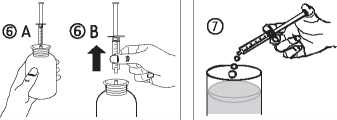
5. Drink the whole contents of the glass/baby's bottle immediately.
6. Close the bottle with the plastic screw cap. Wash the syringe with water (figure 8) and store in a clean place.
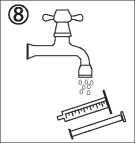
If you take more Clobazam than you should
If you take more Clobazam than you should, tell your doctor or go to your nearest hospital casualty department straight away. Do not drive yourself, because you may start to feel sleepy. Remember to take the medicine pack with you. This is so that the doctor knows what you have taken.
If you forget to take Clobazam
► If you forget to take a dose, take it as soon as you remember.
► However, if it is nearly time for the next dose, skip the missed dose.
► Do not take a double dose to make up for a forgotten dose.
If you stop taking Clobazam Keep taking this medicine until your doctor tells you to stop. Do not stop taking Clobazam just because you feel better.
► When your doctor says that you can stop taking Clobazam, you need to do this gradually. Your doctor will help you to do this.
► Stopping the medicine can make you feel stressed (anxiety), confused or depressed. You may also lose your appetite and have difficulty sleeping.
Tell your doctor if this happens.
PIL/UK/MFG013/04-05/v2
If you have any further questions on the use of this medicine, ask your doctor or pharmacist.
4. Possible side effects
Like all medicines, this medicine can cause side effects, although not everybody gets them. You may feel ill after taking this medicine, or notice unusual or unexpected symptoms. If this happens, tell your doctor.
Tell your doctor straight away if you have any of the following side effects:
► Feeling restless, have difficulty sleeping or nightmares
► Feeling irritable or anxious
► Believing things which are not true (delusions)
► Sensing things which are not there (hallucinations)
► Feeling suicidal
► Increased possibility of tripping or falling especially in elderly patients.
► Blistering or bleeding of the skin around the lips, eyes, mouth, nose and genitals. Also, flu-like symptoms and fever. This may be something called 'Stevens Johnson Syndrome' which is a severe blistering rash where layers of the skin may peel off to leave large areas of raw exposed skin over the body. Also, a feeling of being generally unwell, fever, chills and aching muscles. This is something called 'Toxic epidermal necrolysis'.
If you get any of the above side effects, your doctor may decide that your treatment needs to be stopped. These side-effects are more likely to happen in elderly people and children.
Tell your doctor or pharmacist if any of the following side effects get serious or lasts longer than a few days, or if you notice any side effects not listed in this leaflet.
The following side effects are more likely to happen at the start of treatment. They usually last for a short time:
► Feeling sleepy or dizzy
► Dry mouth, constipation
► Loss of appetite, feeling sick
► Shaking fingers.
Other side effects include:
► Headache
► Breathing problems
► Loss of memory, confusion
► skin rash
► Muscle weakness
► Problems walking or other movement problems
► Being aggressive
► Reacting to things more slowly than usual
► Eye problems such as double vision and rapid uncontrolled movement of the eyes
► Difficulty in staying awake or alert
► Becoming dependent on Clobazam (also called 'physical or mental dependence')
► Weight gain
► Loss of sexual drive.
If you take this medicine for a long time, you are more likely to get the following side effects:
► Anxiety
► Confusion, depression
► Loss of appetite
► Difficulty sleeping
► Dependence
Reporting of side effects
If you get any side effects talk to your doctor or pharmacist. This includes any possible side effects not listed in this leaflet. You can also report side effects directly via the Yellow Card Scheme at www.mhra.gov.uk/yellowcard in UK.
By reporting side effects you can help provide more information on the safety of this medicine.
► For 10mg/5ml: Discard 60 days after first opening.
► Do not throw away any medicine via wastewater or household waste. Ask your pharmacist how to dispose of medicines you no longer use. These measures will help protect the environment.
I I
6. Contents of the pack and other information
\_/
What Clobazam contains
The active substance is clobazam.
Each 5ml of oral suspension contains 5mg clobazam.
Each 5ml of oral suspension contains 10mg clobazam.
The other ingredients are methyl parahydroxybenzoate (E218), citric acid monohydrate (E330), sodium citrate (E331), sucralose (E955), xanthan gum (E415) and purified water.
What Clobazam looks like and contents of the pack
Clobazam is white to off-white viscous liquid supplied in an amber glass bottle with tamper-evident child resistant plastic screw cap and a 5ml polypropylene oral syringe with 0.1ml graduation mark and an adaptor for the syringe. Where higher doses are to be administered, dosing cups should be considered.
Clobazam is supplied in bottles containing 100ml and 150ml suspension.
Not all pack sizes may be marketed.
POM
Marketing Authorisation Holder and Manufacturer:
Syri Limited t/a Thame Laboratories Unit 4, Bradfield Road,
Ruislip, Middlesex,
HA4 0NU, UK
This medicinal product is authorised in the Member State of the EEA under the following names:
UK and IE:
Clobazam Thame 5mg/5ml Oral Suspension Clobazam Thame 10mg/5ml Oral Suspension
This leaflet was last revised in 12/2015.

Thame Laboratories —
5. How to store Clobazam
► Keep this medicine out of the sight and reach of children.
► Do not use after the expiry date which is stated on the carton or bottle after 'Exp'. The expiry date refers to the last day of that month.
► This medicinal product does not require any special storage conditions.
► For 5mg/5ml: Discard 30 days after first opening.